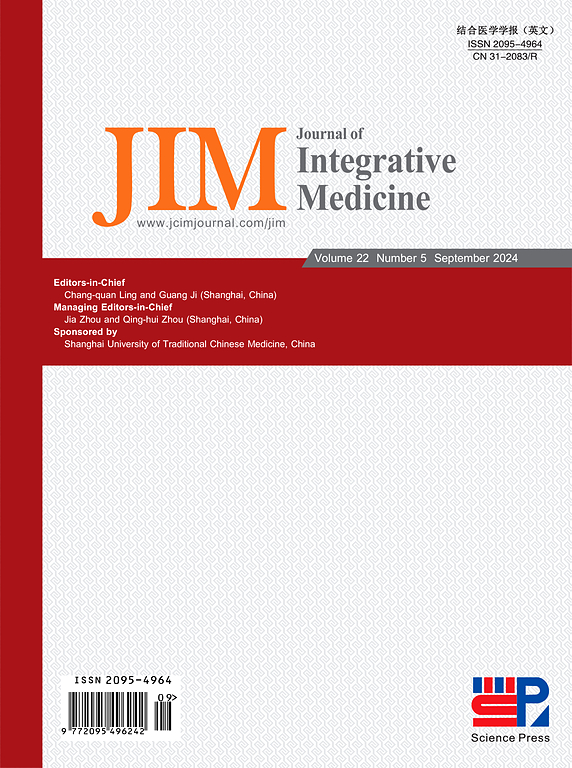A survey on the real-world clinical utilization of a traditional acupuncture in Republic of Korea: Sa-am acupuncture
IF 4
2区 医学
Q1 INTEGRATIVE & COMPLEMENTARY MEDICINE
引用次数: 0
Abstract
Objective
This study investigated the clinical details and usage of Sa-am acupuncture in Korean medicine clinics and explored how practicing Korean medicine doctors (KMDs) think about Sa-am acupuncture.
Methods
We conducted a questionnaire-based survey of KMDs who utilize Sa-am acupuncture in their practice. The study comprehensively investigated issues related to clinical application of Sa-am acupuncture, needling techniques used during treatment, training methods, and directions for its future improvement.
Results
We analyzed 572 responses. An average of 50% of the patients visiting Korean medicine clinics were receiving Sa-am acupuncture. The most prevalent indication for Sa-am acupuncture use was digestive disorders. The patients’ appetite level and digestive function were most frequently used indicators for selecting acupuncture points. Regarding prescription compositions, Jung-Gyuk formulas were more frequently used than Seung-Gyuk formulas. Inserting the needle along the flow of the channel or against the flow of the channel was most popular. The acupuncture style most frequently used in combination with Sa-am acupuncture was Ashi point acupuncture. Strengths of Sa-am acupuncture included its versatility, easy application, and good outcomes. Limitations included the lack of rigorous education and training programs, difficulty in applying the principles for beginners, and insufficient clinical research evidence.
Conclusion
In clinics where Sa-am acupuncture is available, KMDs were providing Sa-am acupuncture to about half of their patients. Practitioners were not using all of the tonification and sedation techniques which may be due to time constraints or simply a lack of necessity. Sa-am acupuncture demonstrated high utility in clinical practice and high satisfaction based on the efficacy and safety. More training programs and high-quality research are needed to help expand the use of Sa-am acupuncture.
Please cite this article as: Park JY, Lee YS, Park HJ, Lee SK, Lee JW, Kim SY. A survey on the real-world clinical utilization of a traditional acupuncture in Republic of Korea: Sa-am acupuncture. J Integr Med. 2024; 22(5): 570–578.
大韩民国传统针灸临床实际使用情况调查:萨岩针灸。
目的:本研究调查了萨阿姆针灸在韩医诊所的临床细节和使用情况,并探讨了执业韩医对萨阿姆针灸的看法:本研究调查了萨姆针灸在韩医诊所的临床细节和使用情况,并探讨了执业韩医(KMDs)对萨姆针灸的看法:我们对使用萨姆针灸的韩医进行了问卷调查。研究全面调查了萨姆针灸的临床应用、治疗过程中使用的针刺技术、培训方法以及未来改进方向等相关问题:我们分析了 572 份回复。平均有 50%到韩医诊所就诊的患者接受了萨阿姆针灸治疗。使用萨姆针灸最普遍的适应症是消化系统疾病。患者的食欲水平和消化功能是最常用的选穴指标。在处方组成方面,正谷方的使用率高于承谷方。顺经或逆经进针最常用。与萨阿姆针法结合使用最多的针法是阿是穴针法。萨阿姆针法的优势在于其多功能性、易于应用和良好的疗效。不足之处包括缺乏严格的教育和培训计划,初学者难以应用其原理,以及临床研究证据不足:结论:在提供萨姆针法的诊所中,韩国医疗团队为大约一半的患者提供了萨姆针法。医生们并没有使用所有的补益和镇静技术,这可能是由于时间限制或仅仅是缺乏必要性。根据疗效和安全性,萨姆针灸在临床实践中表现出很高的实用性和满意度。需要更多的培训计划和高质量的研究来帮助扩大萨姆针灸的应用。本文引用如前:Park JY, Lee YS, Park HJ, Lee SK, Lee JW, Kim SY.大韩民国传统针灸临床应用现状调查:Sa-am针灸。J Integr Med.2024; Epub ahead of print.
本文章由计算机程序翻译,如有差异,请以英文原文为准。
求助全文
约1分钟内获得全文
求助全文
来源期刊

Journal of Integrative Medicine-Jim
Medicine-Complementary and Alternative Medicine
CiteScore
9.20
自引率
4.20%
发文量
3319
期刊介绍:
The predecessor of JIM is the Journal of Chinese Integrative Medicine (Zhong Xi Yi Jie He Xue Bao). With this new, English-language publication, we are committed to make JIM an international platform for publishing high-quality papers on complementary and alternative medicine (CAM) and an open forum in which the different professions and international scholarly communities can exchange views, share research and their clinical experience, discuss CAM education, and confer about issues and problems in our various disciplines and in CAM as a whole in order to promote integrative medicine.
JIM is indexed/abstracted in: MEDLINE/PubMed, ScienceDirect, Emerging Sources Citation Index (ESCI), Scopus, Embase, Chemical Abstracts (CA), CAB Abstracts, EBSCO, WPRIM, JST China, Chinese Science Citation Database (CSCD), and China National Knowledge Infrastructure (CNKI).
JIM Editorial Office uses ThomsonReuters ScholarOne Manuscripts as submitting and review system (submission link: http://mc03.manuscriptcentral.com/jcim-en).
JIM is published bimonthly. Manuscripts submitted to JIM should be written in English. Article types include but are not limited to randomized controlled and pragmatic trials, translational and patient-centered effectiveness outcome studies, case series and reports, clinical trial protocols, preclinical and basic science studies, systematic reviews and meta-analyses, papers on methodology and CAM history or education, conference proceedings, editorials, commentaries, short communications, book reviews, and letters to the editor.
Our purpose is to publish a prestigious international journal for studies in integrative medicine. To achieve this aim, we seek to publish high-quality papers on any aspects of integrative medicine, such as acupuncture and traditional Chinese medicine, Ayurveda medicine, herbal medicine, homeopathy, nutrition, chiropractic, mind-body medicine, taichi, qigong, meditation, and any other modalities of CAM; our commitment to international scope ensures that research and progress from all regions of the world are widely covered. These ensure that articles published in JIM have the maximum exposure to the international scholarly community.
JIM can help its authors let their papers reach the widest possible range of readers, and let all those who share an interest in their research field be concerned with their study.
 求助内容:
求助内容: 应助结果提醒方式:
应助结果提醒方式:


